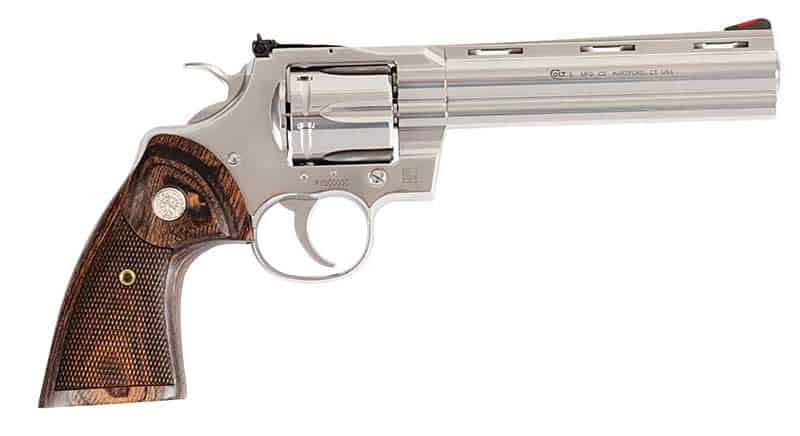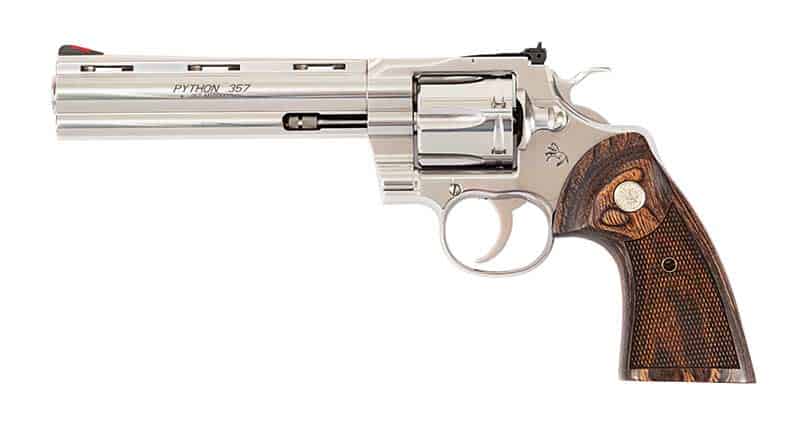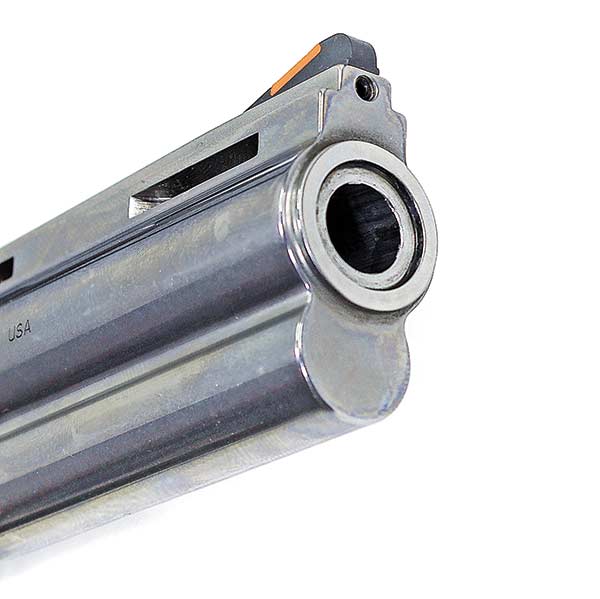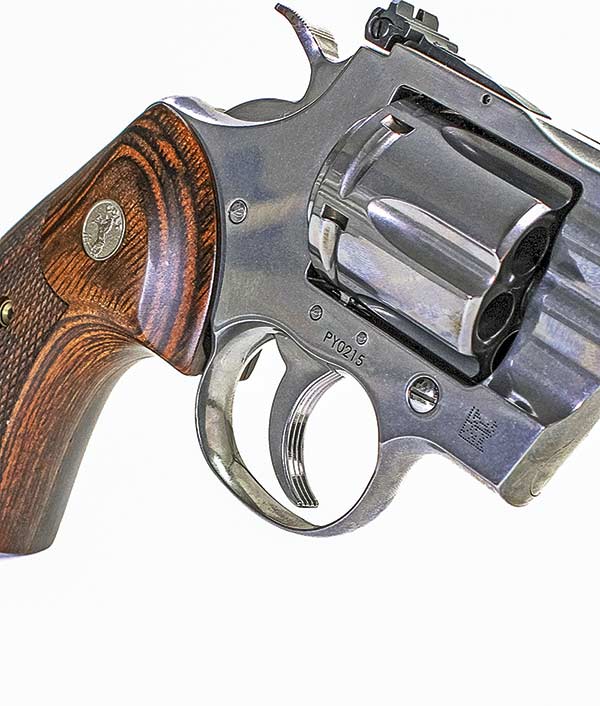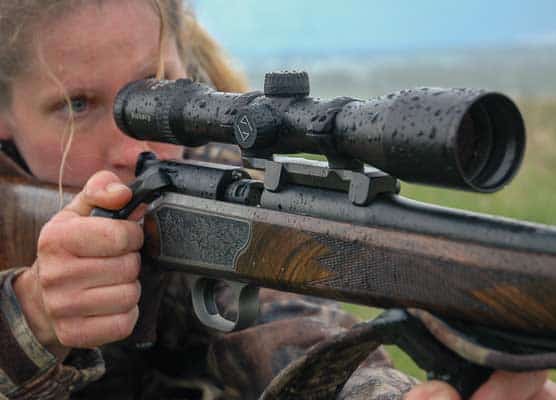Python Guts
Understanding Colt’s Best Revolver Yet

The 2020 Python (left) with its allegedly “superior” ancestors. Clayton
owns them all and says: The new Python can hang with the best! The
infamous “V” spring of the old Python (inset, right) was changed to a
“U” shape to prevent “stacking.” Also note the differing thickness of the
backstrap — the new Python is significantly stronger in several areas.
In 2005, Colt committed the unspeakable by discontinuing its iconic Python. For many, the decision portended the end of an era — indeed, the company’s next chapter would be dictated by CPAs and MBAs, the chasing of government contracts, and almost total indifference to the civilian market. For 15 years, shooters lamented the Python’s loss.
Today, there’s a new sheriff in town. A reborn Colt kicked the saloon doors wide open in 2017, reintroducing the Cobra and seeking to once again win the hearts and minds of serious shooters. You’d think just about everyone would have whooped and hollered with joy when it was announced — at long last — the Python was returning.
But human nature is an interesting thing. As soon as this news broke, so began a great round of bellyaching and pontificating. “They won’t make ’em like they used to,” the internet grumbled. “Doubt it will ever be as good as the old ones,” many opined. Nearly three years later, an aura of suspicion continues to surround the revolver.
As a shooter of Colts across several generations, I felt entitled to an opinion about the new gun’s quality. However, to get an even better understanding of the platform, I talked to Justin Baldini, Colt’s head of product development, and Michael Heffron, head gunsmith of Heffron Precision who will have worked on more than a thousand of the new Pythons by the time this article goes to print.
Putting it all together, I can say this: It’s true this new Python is indeed different from the guns of yesterday — it’s flat out better.
It’s Stronger
Perhaps the biggest Achilles heel of the old design was its tendency to go out of time. Vintage Colts are praised for their “bank vault” lockup. However, to achieve this result, Colt designed the hand to press against the cylinder throughout the recoil process. It was a foregone conclusion this part would eventually need to be replaced by skilled hands, of which there are far fewer these days.
On the old Pythons, magnum loads and aggressive DA shooting accelerated timing issues. I asked Mike how quickly a user would run into these telltale problems on vintage guns if fed max-power ammo. “Typically within three or four thousand rounds,” he said, “although if you’re running the guns hard in double-action, it could be as few as two to three thousand.”
Mike did mention an older Python of his has digested 71,000 rounds over a matter of decades. “Of course, I’ve had to re-time it 14 times,” he added. By way of comparison, Mike’s magnum round count on his new Python sits at 17,000. “Tight as the day I acquired it,” he said.
This durability can be explained largely by the quality of the Python’s internal parts. If they aren’t forged — like the hammer and trigger — they’re formed through aerospace-grade metal injection molding (MIM). Mike tells me his tests of these parts astounded him. Simply put, most MIM parts are surface-hardened but far softer below. The Python’s MIM parts, however, are nearly uniform in hardness.
The new Python is also a little beefier. As Justin explained, “In testing of original Pythons we found some frame stretching when we got into higher round counts. By redesigning the rear sight, we were able to add material back into the top strap, which is really what gives the new Python the additional strength.”
The key takeaway: This gun will not quit on you. Feed it as much magnum ammo as your budget and wrists allow. Dry-fire it to your heart’s content.
It’s More Accurate
Vintage Pythons are unequivocally praised for their accuracy. They were so revered, in fact, numerous gunsmiths in the ’70s and ’80s created “Smythons” and “Cugers” mating Python barrels to S&W and Ruger wheelguns, respectively. They were ugly, but they could shoot!
I asked Mike what Ransom Rest testing revealed about the accuracy potential of the new guns. He did not mince words. “New Pythons, as consistent as can be, will shoot more accurately than the old ones,” he said. Credit today’s era of CNC manufacture for this phenomenon. Colt’s barrel-making prowess is alive and well, but accuracy is further aided by greater dimensional uniformity of forcing cones and cylinder throats. How good are we talking? Suffice it to say a 2″ group at 100 yards is within the mechanical capabilities of a well-tuned snake.
The Double Action Is Better
Some have praised the “buttery smooth” DA trigger of the vintage Python, though I’ve never shared this enthusiasm. The double action of a Colt E/I frame is smooth, true, but most of them are predictably heavy, long and prone to a phenomenon where the weight of pull sharply increases at the end of the trigger’s travel. This is known as “stacking.”
Most of the stacking issue was caused by the “V” spring of previous Colt generations. It has since been redesigned into a “U” shape, and the rest of the lockwork has been revised and simplified — addition by subtraction, if you will. The result is a clean and consistent DA pull I think is one of the best on the market.
But — a Few Concerns
Not all is rosy. The double-action trigger is excellent, but the factory single-action trigger measured 5.5 lbs. on my Wheeler scale with some creep — serviceable, but not astounding. We shooters have various government entities and their drop testing requirements to thank for this state of affairs.
Additionally, the rear sight is underwhelming. I didn’t like its lack of positive click adjustments and the unit requires a ’lil baby Allen wrench to tighten a set screw. If the screw backs out, which it did during my second range session, the rear blade will drift. Some of this is fixable with Loctite, though it somewhat spoils the benefit of an adjustable sight, no?
Thankfully, the aftermarket comes to our rescue. Gunsmiths like Mike are becoming very, very familiar with the geometry of the new Colts and can deliver a sweet trigger without issue. Additionally, Wilson Combat has released a set of front and click-adjustable rear sights for the Python that effectively solve all complaints of the factory design. Beyond functionality, I’d argue the gold bead front sight adds a touch of class and elegance especially befitting this new Python. These sights should be the factory default.
Some will consider my assessment of the new Python incomplete if I fail to mention the gremlins affecting exceedingly few numbers of early models, such as light strikes and the possibility of the hand slipping off the ratchet if the sideplate was loose. While I feel this problem was overblown — in part because of two YouTubers — Colt proactively rectified both issues to make them both virtual impossibilities on current guns.

The 2020 Python (left) with its allegedly “superior” ancestors. Clayton
owns them all and says: The new Python can hang with the best! The
infamous “V” spring of the old Python (inset, right) was changed to a “U”
shape to prevent “stacking.” Also note the differing thickness of the backstrap —
the new Python is significantly stronger in several areas.
A New Legacy
Everyone seems to have an opinion on this new Python. However, it’s become clear over the last three years not everyone has a qualified opinion. I’ve said it before, and I’ll say it again: The Colt Python (of any vintage) is a gun living in the shadow of its own reputation. To properly assess this new model requires stripping away the mythos and nostalgia of the Python and to instead evaluate what the revolvers have been and are now.
As an owner of Colt, Ruger, S&W and Manurhins scattered across more than 100 years of manufacture, I felt the reintroduced Python was a home run. Now having evaluated the gun from a mechanical, metallurgical and engineering perspective, and thanks to the insights of those who know more than I do about the platform, I have all the more faith in my initial assessment. This new generation of the Python is the best yet.
MSRP: $1,499
